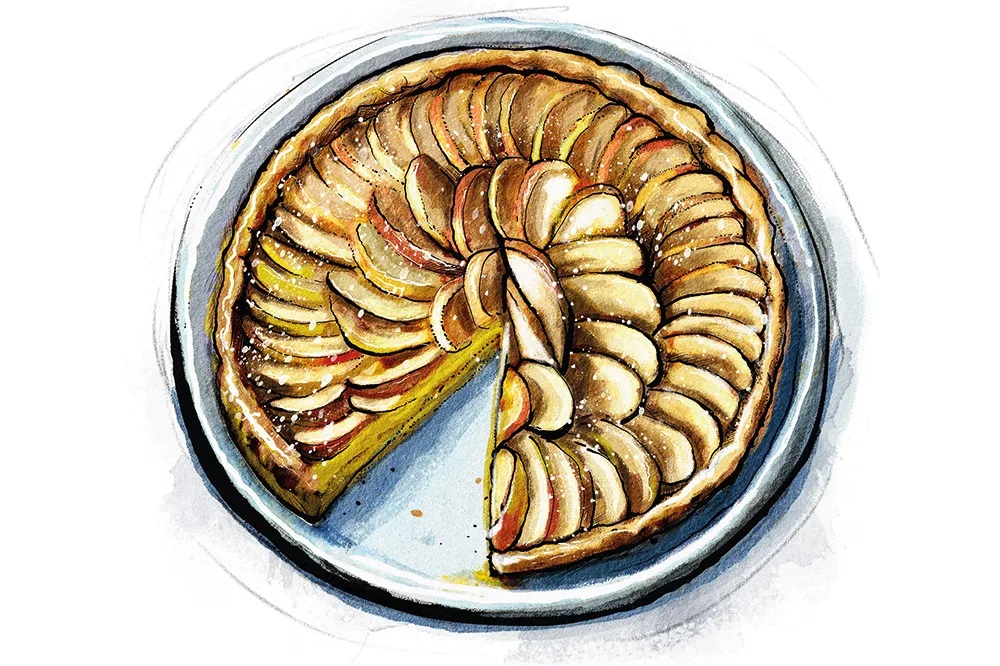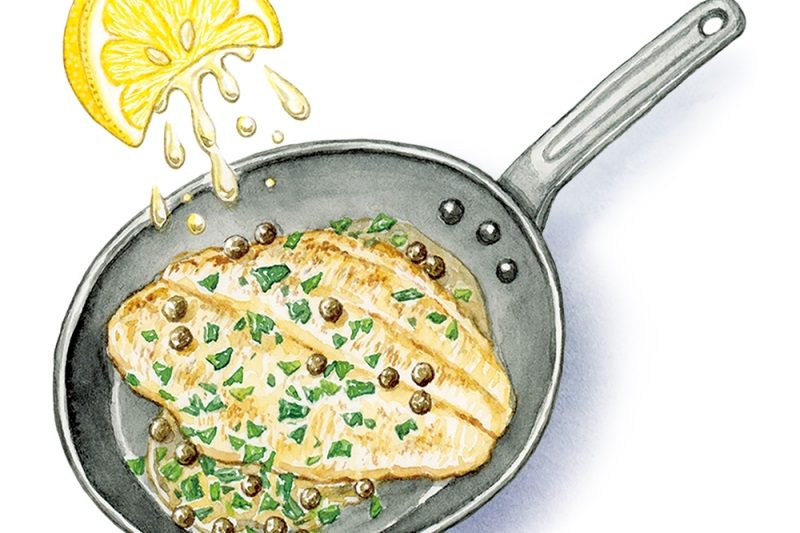There is, as the saying goes, more than one way to skin a cat. The same could be said — although rather more appealingly — about the number of ways to make a French apple tart.
French apple tarts are ubiquitous in their home country but, despite the umbrella name, no two recipes are the same. Usually, it is made without a recipe, seemingly without thought — just by muscle memory, passed down from family member to family member, an inheritance in pastry. It follows, therefore, that an apple tart is as individual as the cook who makes it.
It does feel rather timeless — rolling out pastry you’ve made, arranging apple slices into circles
Because of this, the tart itself varies wildly — the only real constants are some sort of pastry base, and the filling being both apple and, usually, uncovered. But the pastry can be shortcrust, sweetcrust, flaky or puffed. Some cook the apples in advance, others cook them raw; some employ almond or egg-based fillings underneath the apples, others wouldn’t dream of it.
Unlike dishes which come from restaurants, explicitly invented by famous chefs, or committed to paper by well-known food writers, there is often no definitive version of dishes that have lived their lives in home kitchens. That is naturally part of their charm. It’s a type of cooking that we romanticize, yes, but also one I think we genuinely and legitimately hanker after.
It’s an old-fashioned type of kitchen knowledge, which comes from a time when technical culinary skill was a given, when cooking formed a bond between generations and when families often lived more closely than they do today. This isn’t an uncomplicated history: many of the reasons we have lost this legacy knowledge are due to greater gender equality, social mobility, the sheer ease and availability of prepared food.
But that means that, in the right circumstances, cooking can be a simpler pleasure today; what was once a necessity is now a choice. And when you’re making something like apple tart, it does feel rather timeless — rolling out pastry you’ve made yourself, carefully arranging a bowlful of apple slices into concentric circles.
I’ve decided that when it comes to a homemade apple tart, simplicity is key, so my version — sometimes called a tarte fine aux pommes, or thin apple tart — takes it back to its very simplest form: a disc of flaky pastry topped with peeled, sliced apples, dotted with butter and sugar.
You can do this with shop-bought puff, but it’s harder today to get your hands on ready-made puff pastry that is made with real butter. When you’re using so few ingredients, the flavor and depth that butter brings does make a difference. So I make this tart with rough puff pastry.
Rough puff pastry (which I always feel should be written as it sounds, ruff puff, like a dog presenting a cookery show) is made by incorporating fat curls of very cold butter into the pastry and then folding it a few times to create layers that will rise and puff in the oven. It’s much easier to handle than “proper” puff, which requires an even slab of butter that must be folded in exactly the right way at the right temperature. Rough puff is faster and far more tolerant, and the result is beautiful: tender, flaking, golden, and rich with butter.
Tart eating apples are what you want here: I like Braeburns, but if you have access to something crisp and bright, do choose another variety. Just avoid cooking apples, which will break down and lose their integrity.
A hot oven will make the pastry rise and flake beautifully, as well as caramelizing — almost scorching — the apples before they have a chance to collapse and dissolve. And a final lick of apricot jam or apple jelly gives the tart a beautiful gleam, and just the right amount of stickiness.
Serves Six
Takes Forty minutes, plus chilling time
Bakes Thirty-five minutes
For the pastry
– 5¾ oz butter, frozen
– 5¾ oz plain flour, plus extra for dusting
– ⅔ tsp salt
– 2 fl oz ice-cold water
– ⅔ tsp white wine vinegar
For the filling
– 4 crisp eating apples (ideally Braeburn)
– 2 tbsp lemon juice
– 1½ oz superfine sugar
– 1½ oz butter, melted
– 2 tbsp apricot jam or apple jelly
- For the pastry, grate the frozen butter coarsely into a bowl. Stir the butter curl through the flour, then add water and vinegar, and gather it into a shaggy dough. Wrap in plastic wrap and refrigerate for at least thirty minutes
- Roll the dough out into a rectangle approximately twelve x six inches. Fold the top third over the middle third, then fold the bottom third over the other two thirds. Turn it ninety degrees to the right, roll out as before, and fold in the same way. Repeat twice more. Wrap and refrigerate for half an hour
- Roll out to the thickness of two nickels, transfer to a baking paper-lined oven sheet, and refrigerate
- Half fill a large bowl with water, and squeeze some lemon juice in to stop the apples browning. Peel and core them, quarter, then slice each quarter into four, and leave them in the water
- Preheat the oven to 400°F. Remove the pastry from the fridge, and use a sharp knife around a large plate to cut a nine-inch circle. Remove the excess, and prick the pastry circle lightly with a fork
- Lay the apple slices out in circles, working from the outside in, leaving a border of about half an inch at the outside edge. Make sure they slightly overlap. Brush gently with melted butter, and sprinkle with the sugar
- Bake the tart for thirty-five minutes. Warm the jelly or jam slightly and brush the tart with it. Serve immediately
Sign up for Olivia Potts’s bimonthly newsletter, which brings together the best of The Spectator’s food and drink writing, here. This article was originally published in The Spectator’s UK magazine. Subscribe to the World edition here.

























